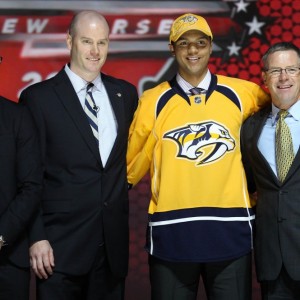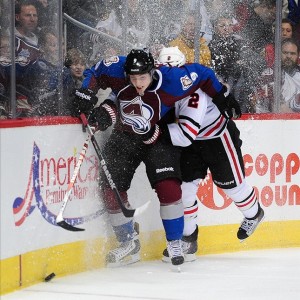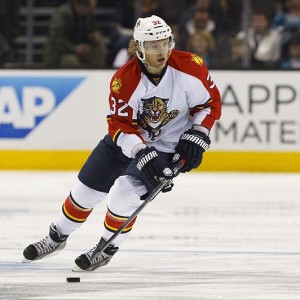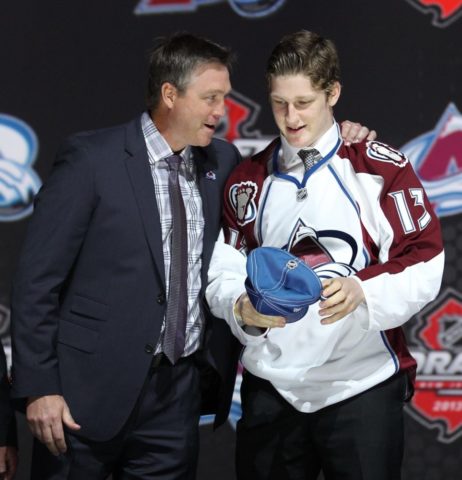The lockout is long gone and the Draft was almost two months ago. Free-agent frenzy is over and arbitration cases have, for the most part, been settled. It’s August… the hockey world calls this “the dead of summer” for a reason.
Hockey fans and media can go one of two ways; look ahead to the upcoming season and project what teams will do or step in the time machine and review the season prior.
Looking at the title, you can guess the direction that this is headed.

The 2013 draft pool was very deep (some experts called this one of the deepest drafts in recent memory). It’s no secret that the teams with high picks wanted to stay pat and pick an up-and-comer (unless that team was New Jersey).
But the seeding was decided by the standings at the end of the shortened season. If you really take a journey back in your memory, you will remember when the debate was how teams will stack up in a 48-game schedule. Would the Edmonton Oilers be elite because they have so many young players that can handle a condensed schedule? Will the Devils and Detroit Red Wings crumble because they are considered “older” teams? Will teams with less players playing in Europe or the AHL fare better because they are more rested?
Looking back, these questions almost seem obsolete. The Chicago Blackhawks were still a dominant team. The Calgary Flames were down and out halfway through the season. The Oilers showed promise but couldn’t bring it all together.
These all are likely scenarios if there were a full 82-game schedule. Looking at each team on paper with past history in mind, it doesn’t seem that a lot changed.
But there were some changes. It’s impossible to tell if things would have played out the same way if the lockout did not happen, but where some teams finished in the standings could be linked to a shorter season.
Columbus Blue Jackets

Unless you were one of the Western Conference teams on the bubble of making the playoffs, you found yourself rooting for the Blue Jackets at some point during the season. Newly acquired goaltender Sergei Bobrovsky stepped in and put on a clinic on a nightly basis, giving his fans hope for the post-season. It took until the last weekend of the season to determine where the Jackets would sit. Sadly, a Minnesota Wild victory over the Colorado Avalanche on April 27 sealed Columbus’ fate, giving the Wild the eighth seed while the Blue Jackets finished in ninth.
The Blue Jackets were the Cinderella story that the NHL needed coming out of a lockout. It gave pure hockey fans someone to root for just for history’s sake. This team was not expected to finish anywhere in a playoff hunt, never mind challenging for third in a very competitive Central Division.
If it wasn’t for Bobrovsky, the 2012-13 Vezina Trophy winner, this team likely would not have finished as the league’s best team to not make the playoffs. If not for the team coming together and adding timely goal scoring (while also trading for Marian Gaborik at the trade deadline), the Blue Jackets would likely have been in the NHL cellar. Remember, this is the team that traded superstar Rick Nash the summer prior with the full intention of entering yet another rebuild.
Because of where the team finished, it drafted at No. 14 in June (Alexander Wennberg). This is a team that could use some NHL-ready talent to keep up with the high-flying teams in the new Metropolitan Division.
The question remains: can Bobrovsky be that good through an entire season? Had there not been a lockout, we would have discovered that a season ago. If he does falter late in 2013-14, the Blue Jackets may have regrets with not having the chance to draft a top player in 2013.

New York Islanders
In rebuild mode for as long as we can all remember, the Islanders found themselves in the same boat as the Blue Jackets. They were a team that was expected to stumble out of the gate in 2012-13, but picked up steam and chugged themselves all the way to an Eastern Conference eighth-place finish. The masterful skills of John Tavares and the timely passing of Matt Moulson led the charge for the young Islanders squad.
The team had some wily veterans (Mark Streit, Brad Boyes and Evgeni Nabokov), but they may fall under what the Oilers were believed to do in a shortened season: win with a young core. Although it did not work out for Edmonton, the Islanders rolled out two top lines that had an average age of 26.3 years old.
This is a team, like Columbus, that could probably use some immediate help. Because of their high finish, the Islanders selected at No. 15 (Ryan Pulock). A Seth Jones or Darnell Nurse may have better served the Islanders as both defensemen are expected to challenge for spots right out of camp (they were taken before the Islanders had a chance to make their pick). Pulock will be a staple on the Islanders’ blue line in the future, but he may need some more time with the Brandon Wheat Kings of the WHL to fully develop.
Colorado Avalanche

On the opposite end of the spectrum from Columbus and the Island, the Avalanche had a disastrous 2012-13 season. This, in turn, gave the Avalanche the first overall selection in the 2013 Draft (Nathan MacKinnon).
When taking fan reaction out of the mix, the lockout actually benefited the Avalanche. The storied franchise was not expected to have a great season but they were believed to be stronger than the lesser Western teams. With talent such as Matt Duchene, Paul Stastny, Gabriel Landeskog and Ryan O’Reilly, the Avalanche should have been able to begin an upswing and challenge for a playoff spot. Instead, they stumbled all year and were never really in contention.
Why was this? It could have been a lack of desire. It could have been coaching, which led to the firing of Joe Sacco as head coach immediately after the season ended. I don’t fully blame either of those excuses.
The Avalanche had just four NHL players from their everyday roster playing professional hockey during the five-month lockout (Duchene, Landeskog, Stastny and Semyon Varlamov). That is the lowest amount that any NHL team had when considering players skating overseas and in the AHL.
Fatigue and conditioning were major factors in the Avalanche’s quest for the playoffs. If the 2012-13 season were a full 82 games, things may have been different in Denver.

Florida Panthers
When Dale Tallon took over as GM of the Panthers, he did everything in his power to make the team his own. He acquired Brian Campbell, Kris Versteeg and Tomas Kopecky, who all played on his former team, the Blackhawks. He also made noise when he completely overhauled the roster, which included bringing in eventual 27-goal scorer Tomas Fleischmann, defensive stalwart Ed Jovanovski and 2011 Lightning playoff hero Sean Bergenheim.
The moves paid off and Tallon saw his team take the 2011-12 Southeast Division title, something that the club had not done since its inception in 1993-94. The organization had high hopes heading into 2012-13 but that faded fast.
The club came out of the gate in January with a dismal 1-5-0 record in its first six games and a 6-11-5 record after its first 22 games. Injuries started piling up and the franchise could not rebound from its disastrous early season. Key injuries included Jovanovski, Versteeg, Scottie Upshall and Stephen Weiss.
The Panthers finished with a league-worst 15-27-6 record for 36 points. They ended up drafting at the No. 2 slot (Aleksander Barkov).
The Panthers’ health could be a result of poor workout regimes or players staying off the ice during the lockout (which is much easier to do if players continued to live in Florida during the duration of the negotiations). The team did have six players overseas but none playing in the AHL from their everyday roster.

Was the lockout the cause for strange seeding in the draft? Did it cause teams that need immediate help to draft mid-range and rising teams to draft higher?
The answer is something that we will never know. All that we can do is debate about the idea until training camps open in September.
Comments are closed.